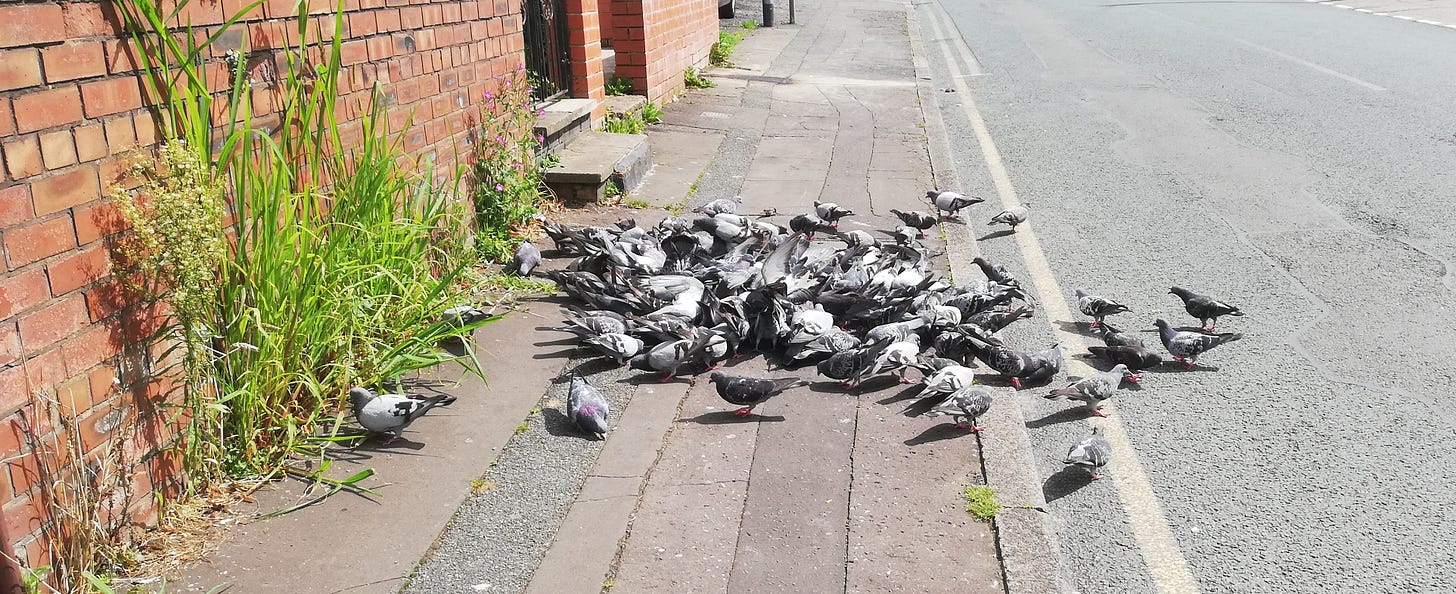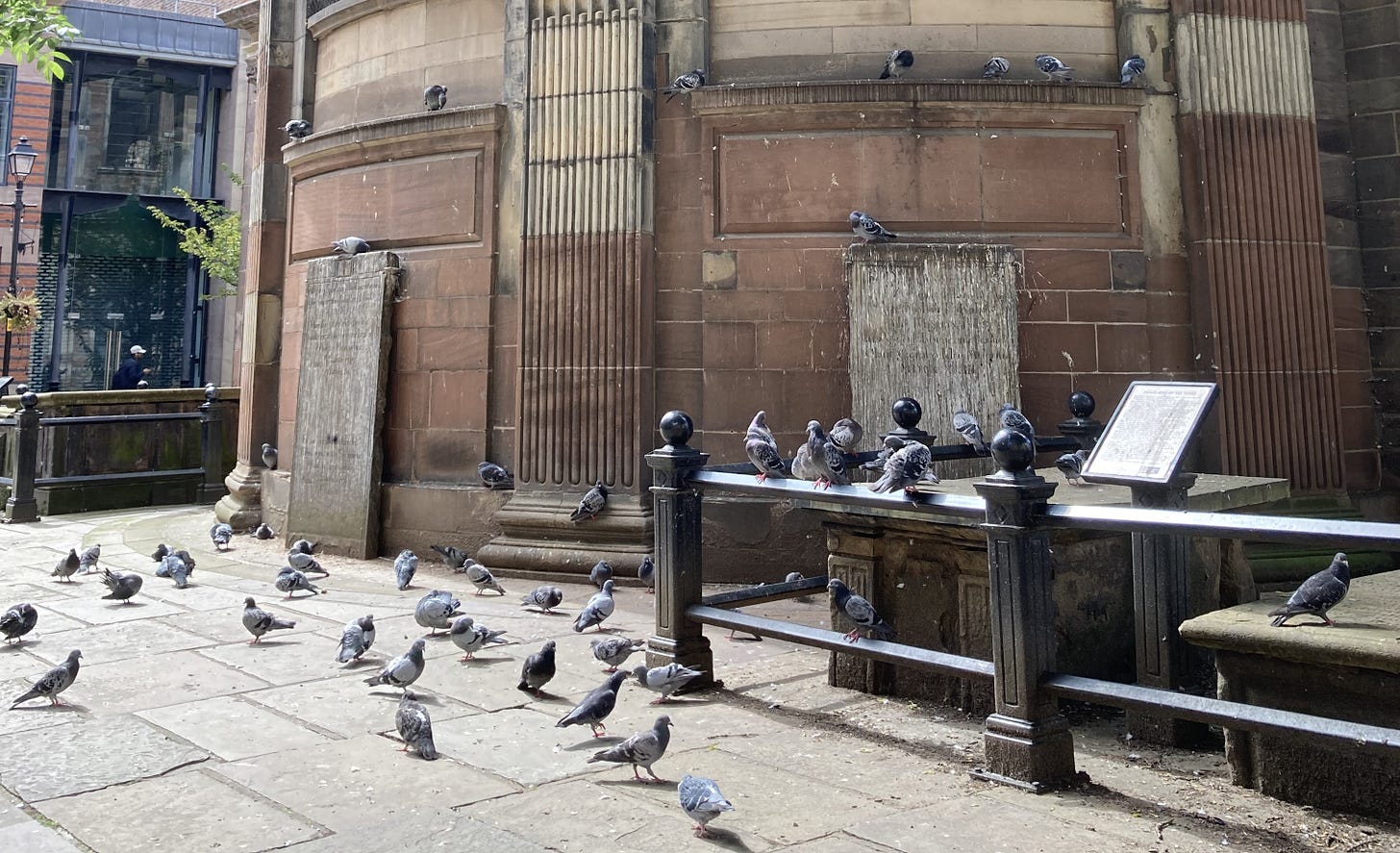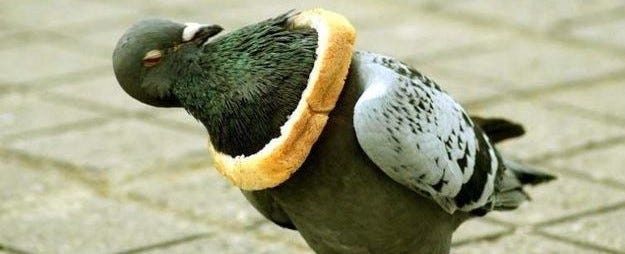Pigeons Can't Swim
And they really shouldn't try: a tale of Urban Humans and Feral Pigeons.
Urban pigeons are everywhere. But they are often ignored or looked down on as grubby, scrappy creatures with nothing to offer. So, when I tell people I fished one out of the Rochdale Canal in Manchester city centre I get strange looks.
First, they ask if it was dead or alive, as if I’d fish a dead pigeon out of a canal (I’m not that strange, I promise). Then there’s normally some mention of bird flu. I confess I didn’t really think about that in the heat of the moment. But, so far, I have not died of a pigeon-borne communicable disease, so it probably won’t be the first thing on my mind if there is a next time. I understand that this is not the most sensible option, but I have hand sanitizer and I like to live on the edge.
The conversation usually ends with ‘why bother’. And I get it. It’s not as if pigeons are an endangered species. In fact, they are considered a nuisance, a ‘problem animal’, and ‘rats with wings’.
But it hasn’t always been this way. Humans and pigeons have a long history together, and at various times we’ve been pretty fond of our grey feathered brethren.
So how did things turn bad? How did we city-dwellers end up hating, or just ignoring, one of our closest urban neighbours?
Unsanitary Pigeons, Sanitary City?
The common narrative is that pigeons are dirty. Because they scrabble around in our human rubbish we see them as constantly filthy. Many don’t even have all their toes because they stand in their own corrosive droppings. These droppings are also a breeding ground for bacteria, disease, and parasites.
Despite preening themselves on the regular, pigeons do pick up dust and grime from their city lifestyles. And they do leave droppings in their nests. However, those missing toes are usually the result of human pollution. Our poor pigeons end up with string and hair (that’s right, human hair) wrapped around their feet, cutting off their circulation and causing necrosis. Funnily enough, there are more pigeons with missing toes in places with more hairdressers.1 We can’t blame pigeons for looking a bit gruesome when it's our rubbish that caused it.
However, the fact remains that bird droppings are a bit nasty and there are illnesses that can be passed between humans and pigeons. People who keep pigeons can sometimes come down with ‘bird fancier’s lung’ caused by breathing the dust from droppings and feathers. You have to be around pigeons a lot for that to happen though. No need to hold your breath walking through the city.
Cleaning up after pigeons is a nuisance, but ultimately it is part of sharing our environment. Our cities have changed over time and pigeons do not fit the concept of a modern, sanitised, urbanity. They disrupt our idea that a city is a purely human place built for a purely human experience.2
Because of this people have shot pigeons, gassed them, poisoned them, electrocuted them, and fed them contraceptives. Window ledges are laced with spikes and sticky gel to stop them nesting.3 Some American cities have employed falcons to reduce their pigeon populations.4 The idea behind this particular scheme is that it’s environmentally friendly for falcons to kill pigeons. Solving a pigeon problem in this manner is meant to be the ‘natural’ way of doing things.
But pigeons live in spaces created by us, and we introduced falcons into those spaces.5 We cannot escape the fact that the interaction between these two birds is entirely created by humans and not really ‘natural’ at all.
This is made more complicated because far from pigeons popping up uninvited, humans have actually enjoyed their company for thousands of years.
Pigeon History
Pigeons are docile. They were the first bird to be domesticated about 10,000 years ago, around the same time as humans were making friends with wolves. As agriculture became a thing and we started to have grain lying around, pigeons began living among humans for the easy food. We clearly didn’t mind this much because they were an excellent source of meat. In fact, we became so fond of them that we started to build pigeons their own houses called dovecotes (believe it or not, pigeons and doves are from the same family). The humble pigeon has provided food for Roman feasts and medieval banquets with their meat still prized by chefs today.
But because they were free to come and go as they pleased, some of these birds inevitably flew off into the sunset and started flocks of their own. This is where most of our city pigeons come from.6
You’ll see two types of pigeons in our cities. We have plump and fancy looking wood pigeons, or Columba palumbas, with grey, green and pink feathers and an adorable soft coo. We also have the Columba livia forma urbana, also known as the feral pigeon. It was one of these I rescued from its unsupervised swimming lesson. Wood pigeons are the country cousin of the feral pigeon but are now firmly established in urban territory, even posing a threat to the original city pigeon because they are bigger and more aggressive.7 Could we soon see a pigeon coup on the streets of Manchester?
One of these reasons humans have historically been friends with pigeons is because our feathered buddies are smarter than they first seem. Raising and racing pigeons has been incredibly popular in British society, combining the joy of being around animals and the excitement of competition with the cerebral aspect of breeding the birds.8 Although this has been a big thing among the working classes, even the late Queen Elizabeth loved the royal pigeon lofts at Sandringham, and in 2019 the ‘Lewis Hamilton of racing pigeons’ was sold to a Chinese buyer for £1m.9 10
More recently pigeons have been trained to look at scans and identify cancer masses in humans–scientists think they use the same part of their brain that they use to navigate the city streets.11 That little bobbing pigeon head may have more in it than you think.
Say ‘Hi‘ to a Pigeon!
There is a broader idea behind this, beyond the pigeon. Cities are not just a physical space; they are a cultural construction. We have clear ideas about what, and who, should be there and why. But pigeons haven’t always been on the outskirts of human society–we invited them to the party! And while we have different standards of urban cleanliness and sanitation today (although you might not be convinced looking at some of our overflowing bins) we should remember that many animals are simply doing the best with what we have given them.
We tend to separate humans and their achievements from nature. It’s especially easy to do this in a city. This is the nature-culture divide and it misses a very important fact: humans are part of nature.12 Even in our cities we are still animals. We have created an environment for ourselves that is more complicated than your average bird nest, but the concept is the same.
I’m not saying that next time you’re in town you need to buy the nearest flock of pigeons a beer and tell each one how much you love it. No one wants a pigeon-borne disease, no one wants bird droppings on their table at the beer garden, and not everyone wants to fish a pigeon out of a murky Manchester canal. But maybe we should think more carefully about how we see the non-human in our urban environment, even the humble pigeon.
By Charlotte Coull
Frédéric Jiguet and others, ‘Urban Pigeons Losing Toes Due to Human Activities’, Biological Conservation, 240 (2019), 1–17.
Colin Jerolmack, ‘How Pigeons Became Rats: The Cultural-Spatial Logic of Problem Animals’, Social Problems, 55 (2008), 72–94.
Jerolmack.
John-Henry Pitas, ‘Deathly Storytelling in the Ecological City: How Pigeons Became Falcon Food in Baltimore, Maryland’, Social & Cultural Geography, 23.1 (2022), 29–46.
Pitas.
Andrew Blechman, Pigeons: The Fascinating Saga of the World’s Most Revered and Reviled Bird (New York: Grove Press, 2007).
Martin Wainwright, ‘City Pigeons Decline as Country Cousins Come to Town’, The Guardian, 1 January 2008 <https://www.theguardian.com/uk/2008/jan/01/ruralaffairs.conservation> [accessed 4 September 2023].
Martin Johnes, ‘Pigeon Racing And Working-Class Culture in Britain, C. 1870–1950’, Cultural and Social History, 4 (2007), 361–83.
The Royal Pigeon Racing Association | The Royal Connection’ <https://www.rpra.org/pigeon-history/the-royal-connection/> [accessed 26 September 2023].
James Crisp, ‘“Lewis Hamilton of Racing Pigeons” Sells for £1m to Chinese Buyer’, The Telegraph, 18 March 2019
Richard M. Levenson and others, ‘Pigeons (Columba Livia) as Trainable Observers of Pathology and Radiology Breast Cancer Images’, PLOS ONE, 10 (2015).
Annabelle Sabloff, Reordering the Natural World: Humans and Animals in the City (Toronto: University of Toronto Press, 2001).





